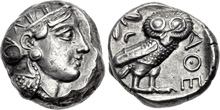Ancients: Owls Through the Years - A Look at the Evolution of Athenian Tetradrachms
Posted on 7/12/2011
Tetradrachms of Athens have long been one of the most popular series amongst collectors of ancient coins. Commonly referred to as “owls,” these coins were struck, with few interruptions, between c.512 B.C. and c.50 B.C. They feature the goddess Athena (the patron deity of Athens) on the obverse and on the reverse, an owl.
Over the years, the thickness and diameter of the planchet changed, as did the relief of the die cutting. Even the weight of Athenian tetradrachms evolved along with the economic fortunes of the host city. Stylistically, the series is divided into three major eras, the exact dating of which remains a controversial topic amongst numismatists and historians.
The first era of Athenian owls, coins struck during the Archaic period of Greek art, began about 512 B.C. and continued through the early fifth century. These issues are characterized by their thick, compact planchets and a crude (but visually striking) style. Introduced by the Athenian king Hippias and supported by a seemingly limitless supply of silver from the mines at nearby Laurium, the first owls represented a standardization of Athenian coinage. They bore the first three letters of the city name (“AΘE”) on the reverse.

Athena, sporting a crested helmet, appears for the first time on the obverse as a crudely executed bust. Athena and her owl are marked by almost cartoonish qualities in both appearance and proportion. On this early example, dated to c. 500 B.C. - 480 B.C., Athena’s eye stares directly at the viewer rather than straight ahead, a trait that would change over the years. The owl is clunky and the posture and proportions seem unnatural.
The owls of Athens began to change noticeably in both style and fabric, and “transitional” types were struck from about 470 B.C. to 450 B.C. Around 450 B.C., Athenian coinage entered a new era - the early Classical period of Greek art, in which design elements were slightly revised and production increased sharply, both trends that would continue for the rest of the fifth century B.C.

Until 404 B.C., when Athens was defeated in the Peloponnesian War, Athena and her owl assume more consistently life-like qualities. For the most part, planchets tend to conform in shape to the bust of Athena, which still retains the facing eye. This piece, which was likely struck between 440 B.C. and 420 B.C., is in many ways the “classic” Athenian owl. It is well-struck, finely executed, and an excellent example of ancient Greek artistry.
The next series of owls, c.393 B.C. - 294 B.C., reflects a transition from the Classical to the Hellenistic period of Greek art and coinage. Athena becomes even more human in response to changing attitudes about representation of the human form in Greek art. It was during this era that her eye was first depicted in-profile rather than facing the viewer. Planchets are more compact, and the owl of Athena has a larger head and slightly different proportions.

This coin, produced between 350 B.C. and 294 B.C., exhibits all of these characteristics.
The dating of Athenian coinage of the third century B.C. is, by and large, speculative. Production of owls continued to decline along with the fortunes of Athens itself. By 229 B.C., Athens had lost all semblance of autonomy to Macedon, and it fell under the control of Rome in the last quarter of the third century B.C. It is assumed that the last of the original series of owls died out by about 200 B.C.
At some point during the second century B.C., so-called “New Style” Athenian tetradrachms began to appear. These coins presented a marked departure from the familiar Archaic, Classical, and early Hellenistic owls of previous centuries. The “New Style” owls reflected contemporary attitudes about both coinage and art. There was a drastic change in the fabric of the coins, as the flans became broader and thinner, and the relief much lower.
Stylistically, the bust of Athena, now modeled after a fifth century cult-statue, reflected the height of Hellenistic influence. The features and proportions became more true to life than ever before. Additionally, the city goddess wears a much more elaborate helmet with three crests.
The reverse of the “New Style” tetra is, if anything, even more altered from its previous format than the obverse. The tried and true tableau of a standing owl, crescent moon, and olive sprig within an incuse square disappeared forever.

This coin, part of the “New Style” series currently dated between c.165 B.C. and the mid-first century B.C., is typical of the series as a whole.
The city of origin, Athens, is denoted in the first line of reverse text (“AOE”). The lines of text and symbols that follow denote the magistrate(s), or moneyers in charge of issuing coinage within the city. A staggering array of moneyer names and symbols appeared on the reverse of new style owls throughout a century and a half of continual issuance.
It is worth noting that by this time the weight standard of Attic tetradrachms had been reduced. Whereas the “old” Athenian tetradrachms tended to weigh somewhere in the neighborhood of 17.00-17.50 g., the new style owls fall comfortably within the 16.25-16.95 g. range.
The last of the Athenian owls were minted sometime during the middle of the first century B.C., though the exact date is unknown and is likely to remain in dispute. The series is amongst the most avidly collected within the world of ancient coins because of its familiar design and historical significance, and it is likely that this will remain the case for a long time to come.
Images courtesy of Classical Numismatic Group
Stay Informed
Want news like this delivered to your inbox once a month? Subscribe to the free NGC eNewsletter today!